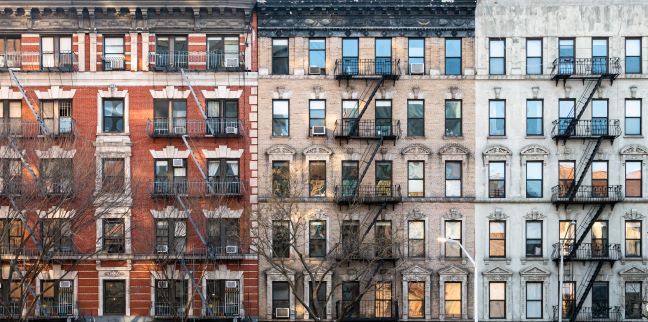When I moved to New York City, people told me over and over: “It’s so expensive!”
They were right. NYC, LA, Boston, DC, San Francisco–all busy cities with great opportunities. But the coveted jobs and access to culture come with price tags as high as the buildings. From rent to groceries, you’ll need to find ways to cut down on those big expenses.
Can you stick to a budget in a big city? Absolutely. Do you need a six-figure income to enjoy the urban life? It doesn’t hurt, but anyone can stretch their city dollars with a little planning.
There are two requirements to being able to afford living in NYC or any big city:
- Keep your largest expenses (housing and transportation) as low as possible.
- Prioritize your discretionary spending and track it religiously.
Housing: Know your priorities

Renting
Renting will likely be your biggest expense. According to Zumper’s National Rent Report, a one-bedroom apartment in Minneapolis averages about $1,400 a month as of January 2024. In Boston, the average is over $3,000.
Despite the surge in costs, rental markets in large cities tend to be competitive. Here’s what to look for when finding an apartment.
Income ratio
As a rule, you should aim to spend no more than 30% of your income on rent. Another way to look at it: Your annual income should be at least 40 times your monthly rent. Landlords may even require you to meet these affordability maximums before renting to you by providing proof of sufficient income. Obviously, you should aim to spend the lowest percentage of your income on rent that you can get away with and tolerate. But in places like NYC or the Bay Area, finding an apartment that costs less than 50% of your income might be laughable.
If that ratio seems impossible to you at first glance, you’re not alone. We’ll cover ways to cut costs below.
Distance
One way to save on rent is to compromise on distance. Rents tend to drop the further you get from the city’s center. Neighborhoods outside the city proper, but that still provide easy access to a bus or train line to the city, may be the way to go. An added bonus: you could get more space for your money.
If you’re in the city daily for work, school, or other responsibilities, you may want to live closer to the action. You’ll save on commuting costs and time. Rents will be higher and spaces more cramped, but you’ll be close to all the city has to offer.
Roommates
For most city dwellers, living with roommates is essential. Combined incomes and cost splitting make large rents affordable. Multiple roommates mean lower costs, not to mention a division of chores and a possible support network.
If you moved to the city solo, someone’s almost certainly renting a room. Craigslist and rental-focused sites like ApartmentList and Apartmentguide can help you find a match. Before you move in, talk with your roommates about financial expectations, such as who’s paying for which utilities.
Is privacy a priority? Budget more money to live on your own. Prepare for a longer apartment search and a more distant location. If you can pay a broker fee up front, going through a broker may help you get the best deal.
Utilities and bills
Are gas, water, heat, and electricity included in your monthly rent? If not, factor these costs into your budget. Don’t forget Internet! And Keeping the heat down in the winter, or going without air conditioning in the summer, can save more than you’d expect.
Maybe you have non-negotiable preferences, such as laundry in the building or proximity to a gym. Or you’d rather be in a small, multifamily dwelling then a large apartment complex. Keep your options open. Be prepared to cut costs in other areas.
Apartment hunting
Do you need a building that allows pets or smoking? Do you need disability accommodations, such as elevator access? You have options, but they may not be the cheapest or most readily available. Ask questions. Get as much information as possible in writing.
Start your search early, two to three months in advance if you can. Leave time for a credit and reference check before you move in.
» There are a lot of websites out there that can help you find the perfect apartment.
Buying
Most city dwellers rent, but not all of them. If you’re planning on staying in the area more than five years, buying a home could save money over time and possibly be a sound investment. You shouldn’t view your primary residence as an investment, real estate in cities where space is at a premium (think New York, San Francisco and Boston) tends to appreciate consistently.
Owning a house in which you rent out rooms—being a landlord yourself—is one way to save. So is living outside of the city but within commuting distance.
Taxes are higher in big cities. With more state and income taxes to pay, you’ll want to consider the effect of property tax on your budget.
The downside to buying in the city is that even the least expensive properties are anything but inexpensive. You’ll need a decent income and good credit to qualify for what could be a very large mortgage.
» Shopping for a home begins with asking ‘How much house can I afford?’
Transportation: Walk, ride, bike, or carpool

If you really want to save, do NOT bring a car. In some metropolises like New York or Chicago, you often don’t need one to get from place to place. No gas expenses, oil changes, or parking nightmares necessary.
In other cities, like sprawling Los Angeles, a car may be essential. Carpool if and when you can. Know the public parking laws to avoid tickets and fines. And don’t drive if you don’t have to. Owning an inexpensive car you drive on a need-to-use or emergency basis may be a reasonable compromise.
Public transit
Get to know the bus and train routes. Most large cities have an efficient public transportation network. They also have price deals designed for commuters.
Buy a monthly pass if you ride daily. If you’re not a regular rider, day or weekly passes may meet your needs. If you use public transit only occasionally, skip the pass and pay the fee per ride.
Whatever option you choose, budget the fee into your calculation of expenses. Some systems, but not all, charge more if you ride longer distances. Buses can be cheaper than trains or subways, but prepare for a longer commute.
Walking and biking
Weather permitting, your feet are the cheapest and healthiest way to get around. You might even save on gym costs. Less money, though, means taking more time.
Try a navigation app, which calculates the distance and cost from Point A to Point B for multiple transportation methods. (Google Maps works too.)
Bikers, know the rules of the road. Travel on bike lanes if possible. Invest in a good lock.
Taxis and ride-sharing
Taxis are best used sparingly. Even with ride-sharing apps like Uber and Lyft or services like Zipcar, costs can add up. Take one in a time crunch, in bad weather, late at night, or to a place not served by public transportation.
Daily spending: Keep a record
One great thing about a big city is the abundance of choice. Shopping, entertainment, food…everything’s available. With so many opportunities nearby, it can be easy to lose track of your purchases.
The trick is to take charge and make a budget you can stick to. Start with tracking your spending. Record what you spend weekly, then monthly. Daily coffees or lattes stack up quickly. Don’t believe it? Try out our latte factor calculator to see just how much those daily couple of dollars amount to over time.
Once you’ve got a grip on what you spend each month, figure out what you need and what doesn’t do you much good. Then plan your purchases. A curb on impulse spending helps you save for the occasional meal out or new outfit for work.
Don’t be alarmed if transition expenses seem high, such as buying the essentials for a new apartment. The day-to-day will be more manageable.
Continue to keep the record, though, and keep perspective. Once you get over the sticker price shock, the higher costs of everything in the big city may begin to seem routine, and you won’t notice how much you’re spending (that’s what happened to me.)
If you can’t keep up with tracking every penny you spend (and few of us can), learn what’s left over after your fixed expenses and savings and prioritize how you want to spend those discretionary dollars. It’s all about priorities!
Food: Plan meals ahead of time

Big cities have great, diverse food—often at high prices, but not always.
Planning meals, whether eaten in or out, will make it easier to avoid being stuck hungry at a location where a pricey restaurant’s the closest option. The occasional spontaneous trip is fun, but as a rule, know where you’re going (or ordering from) ahead of time and how much it will cost.
Carry snacks and water! Food that can travel—sandwiches, fruit, granola bars—work well for an urban, on-the-go lifestyle. A banana comes with its own carrying case. Your water will save you a couple bucks.
And when you’re out and about and you spot a deal, remember where you got it. Diners and out-of-the way spots usually offer good deals at reasonable prices. If you’re a student, bring your student ID for potential discounts.
Grocery shopping can be pricey in the city, and may not seem attractive if you have limited kitchen space. It’s still a good idea to stock up on cooking basics. Rice and pasta are cheap and versatile. Larger stores, like Trader Joe’s and Whole Foods, can have better prices than the more convenient street-corner bodegas. They can be worth the trip.
Your time is valuable, however. Traveling to the grocery store, crossing items off your list, and waiting on line to pay can add up, especially if you head shopping in the rush right after work. That’s where the best meal delivery services become an option, even in a big city. They’re the perfect option in-between pricey takeout you run home to devour and time-consuming grocery shopping (and line-standing).
Fun: Find free attractions
Another benefit to a big city: there’s always something to do. Events are often low-cost or free.
Summer concerts in the park, art gallery openings, film screenings, no-cover comedy shows… cities are great places for unique events intended to attract new participants. If you don’t mind the crowds, and if you don’t spend much once you’re there, free attractions can fill your schedule.
Local blogs and papers are great places to find out what’s happening. Most museums will have certain hours or days with reduced-price or free admission. Again, a student ID comes in handy.
Saving: Rewards cards and spare change apps
You also have to think about how you’re going to save. Of course, putting away a percentage of your income every week or month in an emergency fund and/or high yield savings account is ideal, but we understand this isn’t always an option.
When saving for the future doesn’t feel feasible, earning rewards and cash back can help you cushion your budget a bit and give you something to put away. Rewards credit cards can help you afford to live in NYC or another big city by giving you a way to pay yourself back a little with every purchase. Find one that pays you the best cash back rewards rates on your top spending categories, whether that’s dining, groceries, transportation, or something else.
Spare change apps are another great way to save in the background. These can round up your transactions to help you save and invest automatically (using money you’re not likely to miss).
No matter what: Be creative!

Plan for the unexpected. Challenge yourself. Maybe you’ll find a low-cost restaurant you’d never thought to try, find a new favorite store with great prices, or feel at home in a neighborhood you hadn’t heard of before.
Living in the city broadens your horizons. With planning, an open mind can be as valuable an asset as a trust fund.


